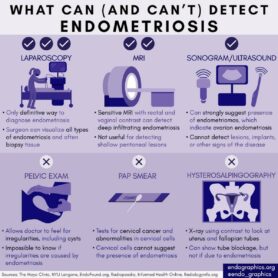Puberty
Menstrual pain is not always normal
By Marijke Stokkel, March 30 2022
Endometriosis is one of the most common gynecological conditions. According to the World Health Organization, an estimated 1 in 10 people with a uterus has endometriosis. Yet it takes an average of 8 years in the Netherlands for a diagnosis to be made. New criteria for endometriosis care aim to change this.

Photo by Polina Zimmerman from Pexels
Everyone has sometimes called in sick because of menstrual pain, or knows someone who has. Maybe your child also suffers from menstrual pain. That’s unpleasant, but also normal, right? Not for every teenager. In some cases the pain is so bad that they can’t get out of bed or go to school. Then they may have a disease like endometriosis. In endometriosis, tissue similar to the endometrium grows outside the uterus which can cause severe pain and chronic inflammation.
Soeraya (20 years old) has had endometriosis for a long time and knows how much it hurts. ‘When I was 13, I got my first period and I immediately knew, this is wrong. I had my period for 3 months in the beginning and I fainted constantly.’ Yet despite her symptoms, it took 6 years before she had a diagnosis.
Menstrual complaints are trivialized
That a diagnosis can take so long has several reasons, according to Dr. Lennie van Hanegem, a gynecologist at UMC Utrecht who specializes in endometriosis. ‘Part of it lies with the unfamiliarity of this disease, both among women themselves and among doctors.’ According to van Hanegem, many people find it normal that menstruation hurts. In addition, endometriosis is often passed on from mother to child. Mothers who are used to a lot of abdominal pain and blood loss during their period may tell their children to take a hot water bottle and paracetamol. According to van Hanegem, this is why many people don’t go to the doctor, or go to the doctor late.
Additionally, not everyone is referred to the gynecologist for menstrual complaints. ‘If you’re lucky, the family doctor will suggest that you start taking the pill, which can suppress the symptoms.’ So it can take a long time before people go to the gynecologist according to van Hanegem. ‘And then
there are also some gynecologists who don’t know that much about endometriosis.’
New criteria for endometriosis care
Because not every gynecologist can adequately recognize or treat endometriosis, new criteria for endometriosis care have been published since January 2022. These criteria are supposed to ensure that endometriosis care is concentrated in specialist centers. According to van Hanegem, who co-wrote the new criteria, specialization of care is very important. ‘The more often you see a patient with a particular clinical presentation, the better you can help those people.’ In addition, according to van Hanegem, doctors can operate better if they do an operation 20 or 30 times a year, than if they do it a handful of times.
Vague symptoms complicate diagnosis
Still it remains difficult to diagnose endometriosis in teenagers. This is because the symptoms in teenagers are much more vague than in adults. The classic symptoms of endometriosis are cyclical abdominal pain, or cyclical bowel or urinary symptoms, for example during menstruation. ‘But by no means does everyone have just that,’ says van Hanegem. For example, teenagers with endometriosis are also more likely to suffer from migraines and chronic fatigue.
In addition bowel and urinary complaints, according to van Hanegem, are often diagnosed as irritable bowel syndrome, while these symptoms can also be caused by endometriosis. This is because the tissue can implant on or around the intestines or bladder which can cause many problems. ‘It’s far from always the case that people themselves have linked it to their menstrual cycle, because why would you link your bowel symptoms to your period?’
Endometriosis in young people is also often more superficial, so it is often not visible on an ultrasound or MRI. There is also no test yet that can detect endometriosis in the blood. In addition, internal examinations are preferably not performed on teenagers because they are often still virgins. The only way then to make a diagnosis is through laparoscopic surgery. ‘That does require someone to go under anesthesia,’ says van Hanegem.

Different diagnostic methods cannot always diagnose endometriosis with certainty. Source: endographics.org
Take complaints seriously
Even though diagnosing teenagers is difficult, it is important that complaints are taken seriously. Otherwise, there can be major consequences, as was the case for Soeraya whose complaints were downplayed for a long time. She says, ‘I came to believe that the pain I was having was not real pain.’ She would therefore urge parents to believe and support their child. Dr. Van Hanegem agrees, but also adds, ‘At the same time it is very complicated, because how can you blame mothers for projecting their own pattern of symptoms, and what they themselves consider normal, onto their daughter?’
More recognition
Fortunately, endometriosis is getting more and more attention, as was the case last March during endometriosis awareness month. Many hospitals and patient organizations, but also radio 3FM and Linda magazine, paid attention to endometriosis. According to van Hanegem, it is difficult to say whether the information reaches the right people. Both Soeraya and van Hanegem agree that menstrual problems should be highlighted more during biology lessons. ‘You don’t even need to do a whole lesson on endometriosis,’ according to van Hanegem. If every biology teacher would say ‘If you have so much pain [during menstruation], lose so much blood that you can’t come to school, go to the doctor’, this would already make a large difference according to van Hanegem
More money for research
In France, endometriosis has been put higher on the agenda and 20 million euros have been made available for research. According to van Hanegem, more research needs to be done on biomarkers. These are substances in the blood that can indicate whether someone has endometriosis, without having to undergo internal examination or laparoscopic surgery.
There also needs to be more focus in the research field on endometriosis in teenagers. This is because most of the research on the causes and possible treatments is conducted on adults. While the disease can behave very differently in adolescents.
Finally, more research needs to be done on new drugs. ‘Everything we give is symptom control, so we suppress the symptoms, we suppress the progression of the disease,’ said van Hanegem. ‘In the ideal world, of course, we would like to give a drug that would stop the endometriosis from progressing causing people to have no more symptoms.’
Sources
de Kok L, van Hanegem N, van Kesteren P, et al. Endometriosis centers of expertise in the Netherlands: Development toward regional networks of multidisciplinary care. Health Sci Rep. 2022;5:e447.doi:10.1002/hsr2.447
Shim JY, Laufer MR. Adolescent Endometriosis: An Update. J Pediatr Adolesc Gynecol. 2020 Apr;33(2):112-119. doi: 10.1016/j.jpag.2019.11.011. Epub 2019 Dec 5. PMID: 31812704.
Images
https://www.pexels.com/photo/woman-curled-up-on-floor-3958576/
https://www.endographics.org/infographics/detectingendometriosis

